The Adelaide Hills is Australia's cool-climate crown jewel—renowned for its elegance, altitude, and innovation. Just 30 minutes from Adelaide, it offers a dynamic blend of tradition and experimentation across stunning terrain. It was with some excitement that I ventured out into this wonderful wine landscape for a one-day sampling of the wines this region has to offer.

Nestled in the Mount Lofty Ranges of South Australia, the Adelaide Hills wine region stretches in a narrow band approximately 70 km long, with vineyards perched between 149 and 714 metres above sea level. Its proximity to Adelaide makes it the most accessible premium wine region from a major city in Australia.
This is one of Australia’s coolest and most elevated wine regions, with a climate marked by cool, dry summers and crisp, wet winters. The diversity in altitude, slope, and soil—from loamy sands to clay subsoils—creates a mosaic of microclimates ideal for crafting expressive wines.
The Adelaide Hills excels in both classic and emerging styles:
- Sauvignon Blanc: Benchmark for Australia—vibrant, aromatic, citrus-driven
- Chardonnay: Elegant, mineral, and often used in top-tier sparkling wines
- Pinot Noir: Silky and red-fruited; also a backbone for sparkling wine
- Shiraz: Cool-climate style—lighter, peppery, and refined compared to warmer regions
- Alternative varieties: Grüner Veltliner, Nero d’Avola, Fiano, and Nebbiolo are gaining traction
Two official subregions—Lenswood and Piccadilly Valley—highlight the region’s extremes. Piccadilly, with its high elevation and cooler temperatures, produces some of Australia’s finest sparkling wines. Lower areas like Macclesfield and Mount Barker favor fuller-bodied reds.
With over 50 cellar doors and a thriving food scene, the Adelaide Hills is a haven for wine lovers and weekend explorers. Many producers offer immersive experiences that blend wine, local produce, and art in a lush, leafy setting.

The historic Tiers Vineyard in front of the Tapanappa Cellar Door
Tapanappa
My first visit of the day, Tapanappa is the legacy of pioneering winemaker Brian Croser, whose pursuit of terroir-driven excellence spans over four decades, with his winemaking career commencing in 1969 at Thomas Hardy & Sons. After completing oenology studies at UC Davis, Brian founded Petaluma in 1969 which became an Australian benchmark for site-specific winemaking with vineyards in Piccadilly Valley (Chardonnay), Coonawarra (Cabernet Sauvignon) and Clare Valley (Riesling). After Petaluma was acquired by Lion Nathan in 2001, Brian eventually left to pursues a more independent terroir-focused vision, founding Tapanappa in 2002. Anchored in the Piccadilly Valley, the historic Tiers Vineyard—planted in 1979—is the birthplace of modern Adelaide Hills viticulture. Tapanappa’s ethos is rooted in matching noble varieties to their most expressive sites, producing wines of clarity, texture, and restraint. From the mineral-laced Tiers Chardonnay to the brooding Foggy Hill Pinot Noir, each bottling reflects meticulous vineyard design and vintage nuance. The cellar door, perched above the Tiers Vineyard, offers a serene, focused tasting experience that invites deep engagement with site and season.
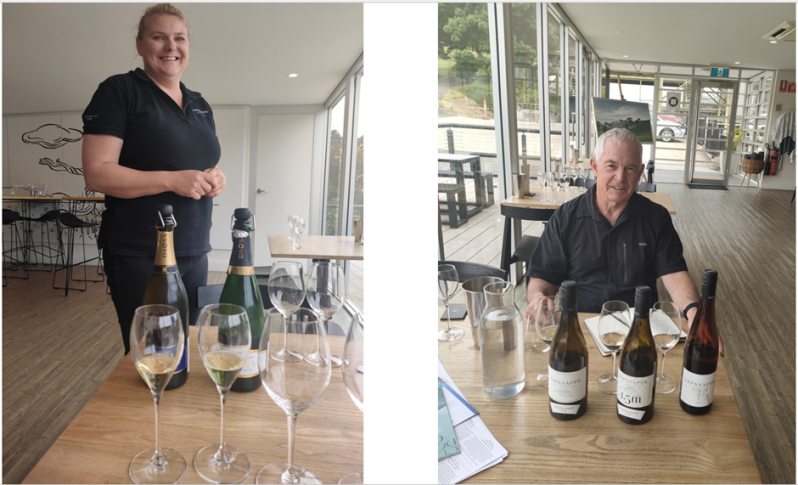
Carla led me through an exciting tasting!
The cellar door also serves as the home for two distinct but closely related wine ventures: Terre à Terre was founded by Xavier Bisot and Brain’s daughter Lucy Croser in 2007 with the planting in 2004 of the Crayères Vineyard with Bordeaux varieties on the terra rossa soils in Wrattonbully. It focuses on still wines with French influence, including the Down to Earth range. In 2012 the same duo launched Daosa, specialising in traditional method sparkling wines from the Bizot vineyard which was first planted by Xavier’s father Christian Bizot in the mid-1990s.
On arrival I was provided a tour of the modern winery by Molly Yang before being guided through a generous and fascinating tasting of all three wine labels by Cellar Door Manager, Carla.
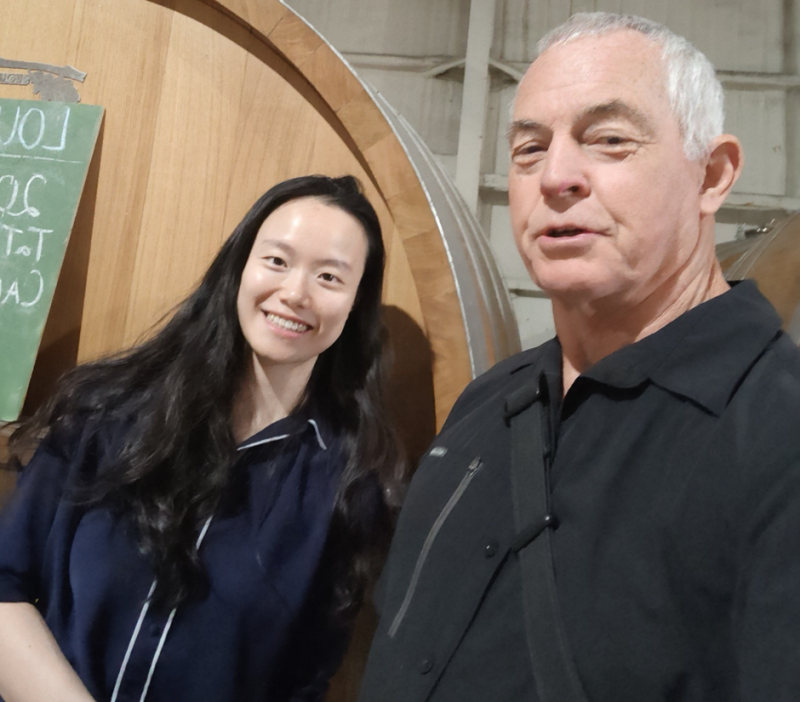
With Molly in the barrel room
The wines tasted are described below:
Daosa Natural Reserve NV. From the 7th release of this sparkling wine, made from 57% Pinot Noir, 35% Chardonnay and 8% Pinot Meunier, Piccadilly Valley grapes mostly from the cool 2022 vintage blended with 15% reserve wine. Bright white florals, grapefruit and toasty lees on the nose, lovely soft creamy mousse, with citrus, apple and gentle spice on the rich palate, a slight phenolic bitter lift on the finish.
Daosa Blanc de Blancs 2020. From the coolee than average 2020 vintage, 100% Chardonnay from the Piccadilly Valley Bizot Vineyard, whole bunch pressed to old oak barrels and left to age for six months on lees until tirage then 42 months in bottle before disgorgement. Aromas of white peach and fresh brioche, the plate is very precise, focused and textured, the finish long and clean, a lovely elegant wine.
Daosa Sparkling Rose 2022. 70%Pinot Meunier, colour from whole bunch pressing at a higher pressure and small amount of pinot noir added prior to tirage. A nose of strawberry, red apple and cinnamon. On the palate lovely energetic mousse with strawberry and read apple flavours, the long fresh finish hinting of strawberry shortcake.
Down to Earth Rose. A multi-varietal blend with Sangiovese and Viognier the major partners, two hours maceration on skins before ferment in stainless and some time on lees. Definite pink in the glass with aromas of strawberry and sour cherry. On the palate, strawberries and cream, fresh but faintly off-dry, straight-forward easy summer drinking.

Part of the extensive lineup of wines tasted
Terre à Terre Crayères Vineyard 2015 Sauvignon Blanc. 100% oak fermented in demi-muids, no malolactic. Lemon straw in the glass with faintly savoury and nutty aromas. On the palate some citrus and tropical fruit flavours are overshadowed by asparagus and canned peas, suggesting this was past its best.
Terre à Terre Crayères Vineyard 2024 Sauvignon Blanc 50% in oak 50% in stainless, light straw in the glass with a smoky edge over citrus and floral aromas. On the palate, quite a soft mineral texture with flavours of lemon curd and apricot, good length.
Tapanappa 2024 Eden Valley Riesling. Light straw in the glass with aromas of jasmine, lime and green kiwi. On the palate soft, textured and delicate with a gentle minerality and a long clean finish.
Tapanappa 2024 Tiers 1.5M Vineyard. From low, close spaced vines French clones planted in 2003 and earlier ripening than the original Tiers alongside it. Grapes are gently whole-bunch pressed, barrel fermented with 9 months oak aging (33% new) on full lees without stirring or malolactic conversion. Light lemon in the glass with distinct saline spray on the nose overlaying white peach and nectarine aromas. On the palate quite rich and faintly smoky with notes of peach brioche and gentle spice.
Tapanappa 2024 Tiers Vineyard (Old Vines). Chardonnay from an unknown clone probably introduced into Australia in the 19th century planted on own roots in 1979 vinified as for the Tiers 1.5M above. Lemon in the glass with a complex nose of cashew, lemon curd, white peach and hint of corn cereal. On the layered palate, sweet ripe stone fruit, cashews and melon are supported by a crisp acid drive to the long rich finish.
Tapanappa Foggy Hill 2024 Pinot Noir. From a small crop in a cool vintage, fully destemmed berries with fermented 16 days with five days maceration, pressed and aged 8 months in French oak barriques (33% new). Light ruby in the glass with aromas of cherry, strawberry and star anise. On the palate light bodied but with still firm tannins, finishing with a slight herbal edge.
Tapanappa Definitus 2022 Pinot Noir. From a distinct section of the Foggy Hill Vineyard on sandstone soils. Medium ruby with a garnet edge in the glass, dark cherry, orange rind, mushroom and sous-bois aromas. Medium bodied with silky soft tannins and gentle oak, the flavours of dark cherry and plum are supported by a delicious savoury complexity of olive tapenade, thyme and sous-bois on the long elegant finish.
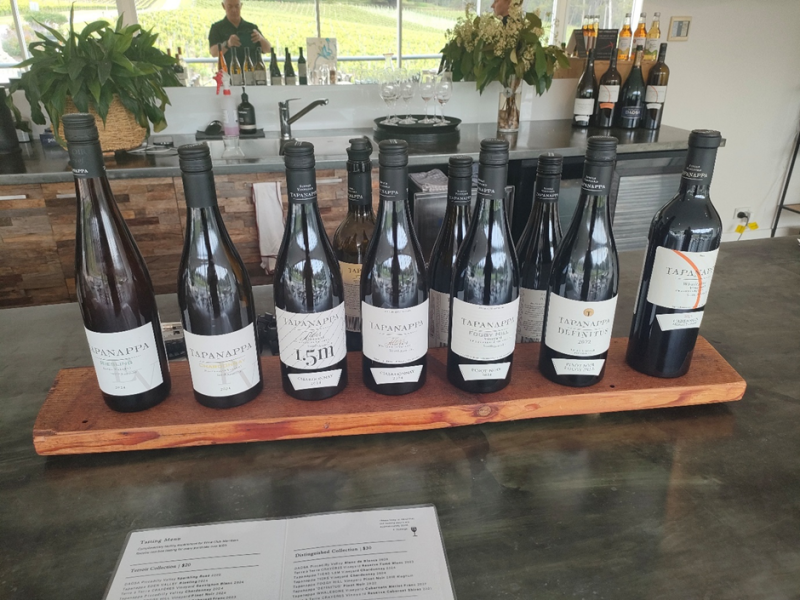
The rest of the wines tasted
Terre à Terre Crayères Vineyard 2023 Cabernet Franc. From high density plantings in 2008, the wine is a blend of 925 Cabernet Franc with 8% Shiraz from the same vineyard aged partly in French oak barrels (20% new) and partly in an old oak foudre for 14 months. Light-medium ruby in the glass with spicy red fruit on the nose and just a hint of cassis. The palate is light and fresh, red berries predominate with some clove spice and tobacco and good length.
Tapanappa Whalebone Vineyard 2021 Cabernet, Merlot, Franc. From 50 year old vines now drawing on the underlying limestone base of the vineyard, the wine is aged in French oak barriques (50% new) for 18 months before the final blend of 53.5% Cabernet Sauvignon, 16% Merlot, 16% Cabernet Franc and 14.5% Shiraz. Dark ruby in the glass with distinct aromas of cassis, dark plum, cherry compote and cedary oak. On the palate rich dark fruit fine chalky tannins and a long finish.
Terre à Terre Crayères Vineyard 2021 Reserve. A blend of the best parcels of Cabernet Sauvignon 58%, Cabernet Franc 21% and Shiraz 21% from the Crayères Vineyard in a perfect vintage, the wine aged in 100% new oak for 14 months then a further 24 months after bottling before release. Deep ruby in the glass with aromas of cassis, liquorice, plum and spice. On the palate quite rich and concentrated with blackcurrant, blackberry and dark cherry fruit, cedary oak, baking spice, and dark chocolate, the fine chalky tannins slightly drying on the long, elegant finish.
Terre à Terre Crayères Vineyard 2024 Late Harvest Sauvignon Blanc. From late harvested fruit, 60% clean, 35% shrivelled and 5% botrytis, fermented and aged in stainless. Pale straw in the glass with subtle aromas of citrus and honey, quite light and fresh on the palate despite the obvious sweetness.
What an excellent start to my introductory day in the Adelaide Hills!
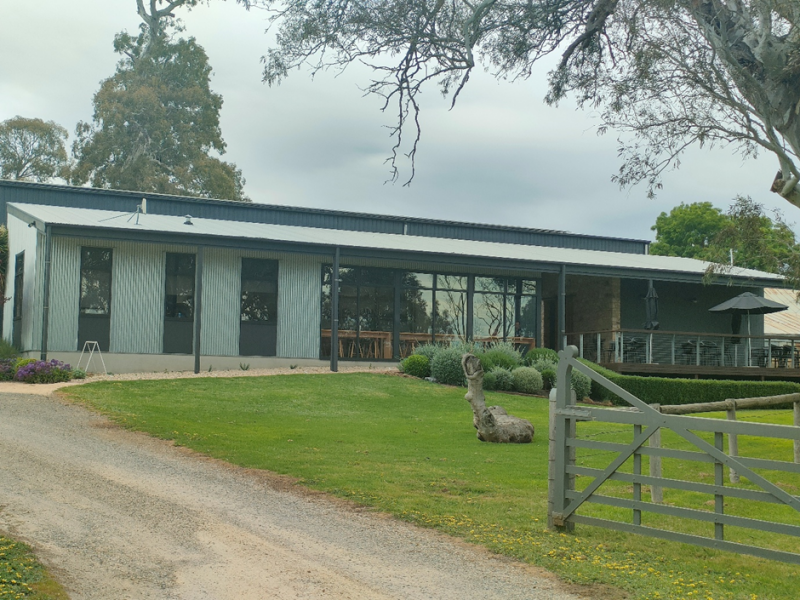
Outside the Murdoch Hill Cellar Door
Next up was a visit to Murdoch Hill. If Tapanappa was a case study in winemaking precision and pedigree, Murdoch Hill was to be more a demonstration of experimentation and energy, yet both clearly terroir-driven in their approaches. Murdoch Hill blends family heritage with avant-garde winemaking, led by Michael Downer—Young Gun of Wine winner and one of Australia’s most exciting talents. From their organically farmed vineyards in Oakbank and Lenswood, Murdoch Hill crafts wines that are vibrant, textural, and site-transparent. The Rocket Chardonnay and Apollo Pinot Noir showcase elevated Lenswood fruit with precision and flair, while the Orion Syrah offers a cool-climate take on Rhône structure. The tasting room, nestled on the family’s historic farm, is intimate and welcoming—ideal for exploring both classic and experimental bottlings, often paired with local cheeses and seasonal flights.
We worked through a tasting of seven expressive wines as follows:
2024 Murdoch Hill Chardonnay. Lemon straw in the glass with distinct aromas of ripe peach, grapefruit, a whiff of toasty oak and hint of reduction. On the palate the lovely creamy texture is balanced by precision and drive with stonefruit and citrus flavours edged with vanilla, yellow apple and whiff of toast. The lively finish has a nice crushed stone minerality.
2023 Tilbury Chardonnay. 80% fruit from Lenswood and 20% from Piccadilly in a cool wet vintage. Lemon in the glass, with primary citrus aromas, a crushed stone minerality and distinct oak. On the palate there is a lively fresh acidity underlying grapefruit and white nectarine flavours edged with toast and vanilla oak, that crushed stone minerality and a long and powerful finish. Very classy!

Inside the Murdoch Hill Cellar Door
2023 Phaeton Pinot Noir, half Piccadilly, half Lenswood fruit with some whole bunches. Pale ruby in the glass with bright strawberry and red cherry aromas and a hint of pepper spice. Light fresh and elegant on the palate with juicy berry fruit and a nice lick of spice on the finish.
2023 Apollo Pinot Noir. Sourced completely from the Lenswood Vineyard. Ruby in the glass with raspberry fruit, sous-bois and baking spice. On the palate quite structured with firm tannins, and the concentrated fruit having a quite savoury expression, one to cellar!
2023 Jupiter Sangiovese. Bright ruby in the glass, this delicious take on the Italian stalwart has the classic Sangiovese nose of sour cherry, crushed herbs and spice. On the palate it is light and fresh with cherry, raspberry, crushed herb and Moroccan spice flavours that drive to a more mushroom savoury finish, very drinkable and sure to be food friendly.
2023 Landau Syrah. A cool year expression of Syrah with violets, pot-pourri, white pepper spice and red berry aromas. Medium bodied on the palate with lovely berry fruit and some brown peppery spice, the tannins are fine and the acidity nicely balanced, an elegant expression of cool climate Syrah, approachable now but will reward cellaring.

2022 Orion Syrah. From an excellent vintage, 21 days on skins and 25% whole bunch, aged for 10 months in oak puncheons 25% new. Deep ruby purples in the glass with an inky core. A nose of violets, black and blue berries, game and smoke edged with black pepper spice. On the palate plush ripe black and blue berries, Doris plums and dark chocolate with a slight herbal edge, the tannins are plush and velvety, the finish is long and satisfying. Definite shades of Northern Rhone!
My last, but by no means least visit of the day was to the iconic Shaw + Smith winery and tasting room in Balhannah. Founded in 1989 by cousins Michael Hill-Smith (Australia’s first Master of Wine) and Martin Shaw, Shaw + Smith is a cornerstone of Adelaide Hills winemaking. With vineyards in Balhannah, Lenswood, Piccadilly, and Lobethal, their focus is on cool-climate varieties—Sauvignon Blanc, Chardonnay, Pinot Noir, and Shiraz—expressed with clarity, finesse, and modernity. The M3 Chardonnay and Lenswood Pinot Noir are benchmarks for the region, combining international polish with local authenticity.
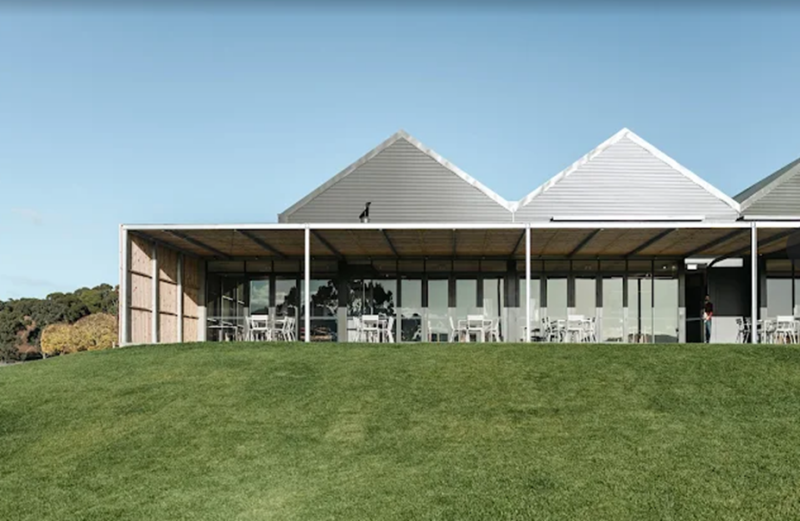
The Shaw + Smith Cellar Door
Initially the venture operated as a warehouse winemaking operation, sourcing fruit from local growers and making wine at other wineries like Wira Wirra and Petaluma. In 2000 the cousins built their own winery and tasting room in Balhannah, marking a shift to a more estate-based model, and developing their own vineyards.
The venture currently has four vineyards as follows:
Balhannah, 35 ha surrounding the winery, mostly to Sauvignon Blanc and close-planted Shiraz at 340-380m elevation on free draining sandy loam over red clay with underlying quartzite and shale and variable amounts of ironstone pebbles.
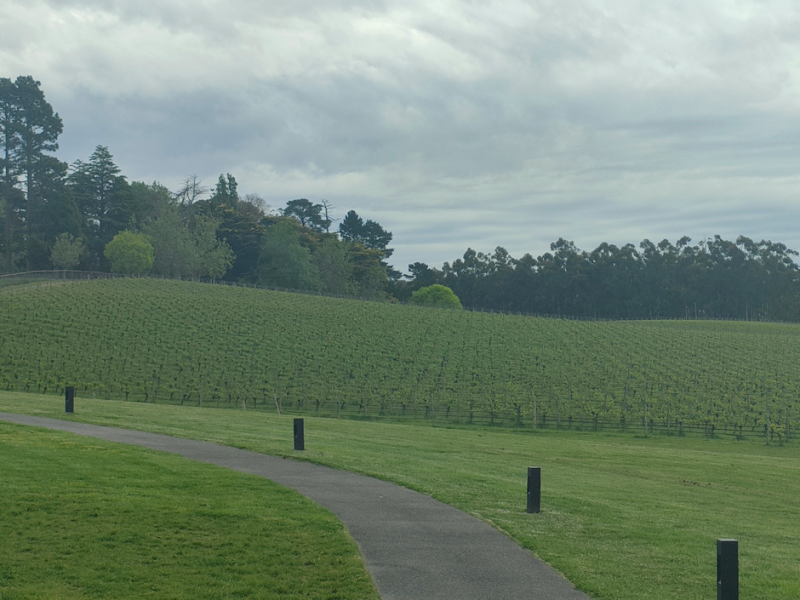
Overlooking part of the Balhannah Vineyard from the Cellar Door
Lenswood, 20 ha about 10km north of the winery, mainly planted in Chardonnay and Pinot Noir at 455-500m elevation with brown loam over clay soils with broken shale on the ridges.
Piccadilly 5.2 ha located 15 km NW of Balhannah in the highest and coolest parts of the Adelaide Hills at 500m elevation. High density Chardonnay & Pinot Noir (10,000 vines per ha) on sandy and clay loam soils with ironstone and quartz.
Loebethal was just purchased in 2024 and has 10 ha of Chardonnay vines on sandy clay soils at 500m elevation.
Shaw + Smith are committed to sustainable winegrowing practices, including the following (from their website).
- No herbicides, synthetic fertilisers and fungicides
- Organic compost-based fertilisers with on-site composting and worm farm
- Mowing and mechanical weed removal
- Shoot and bunch thinning, and vertical shoot position canopies
- Organic canopy sprays for disease control
- High density planting (5000+ vines per hectare)
- Diverse mid-row swards
- Native vegetation areas within vineyards
- Introduction of chickens for natural pest control and manure generation
- Beehive at Balhannah Vineyard
- The winery is run entirely on rainwater and wastewater is reused on site
- Closed loop packaging and recycling & use of lightweight bottles
Sauvignon Blanc was their breakout success demonstrating that world class early drinking examples could be produced in Adelaide Hills. The M3 Chardonnay launched in 2000, named after Martin, Michael and Michael’s brother Matthew, became a flagship wine, showcasing refined winemaking with Dijon clones, wild fermentation and whole bunch pressing.
At their Balhannah estate, tastings are offered as seated wine flights with the option to pair with seasonal small plates, creating a refined yet relaxed experience that reflects their commitment to quality and hospitality. A comprehensive tour of the winery and vineyard is also available followed by an extended wine tasting with matched cheeses. It was my good fortune and delight to be guided by Tristan (below) for the tour and an excellent tasting. The winery is extensive, modern and singularly impressive!

Tristan in the Winery Barrel Room
Following our winery tour, I tasted the following wines.
M3 2024 Adelaide Hills Chardonnay Handpicked fruit mostly from Lenswood, Piccadilly and Loebethal vineyards, whole bunch pressed then gently pressed to French oak (30% new) for fermentation and malo. Pale lemon in the glass with grapefruit pith and white peach aromas along with some distinct toasty vanilla oak. The palate is generous, rich and concentrated but nicely balanced with fresh acidity, white stone fruit and grapefruit flavours and a slight edge of pith on the long finish.
2023 Lenswood Vineyard Chardonnay. From a cool, wet vintage, handpicked and sorted fruit gently whole bunch pressed and fermented in 500 litre puncheons 30% new, with full malo for 10 months. Pale lemon in the glass with poached pear and stonefruit aromas, and a hint of spice. The rich and concentrated palate has good freshness, and flavours of peach crumble, cashews and spice, finishing long.
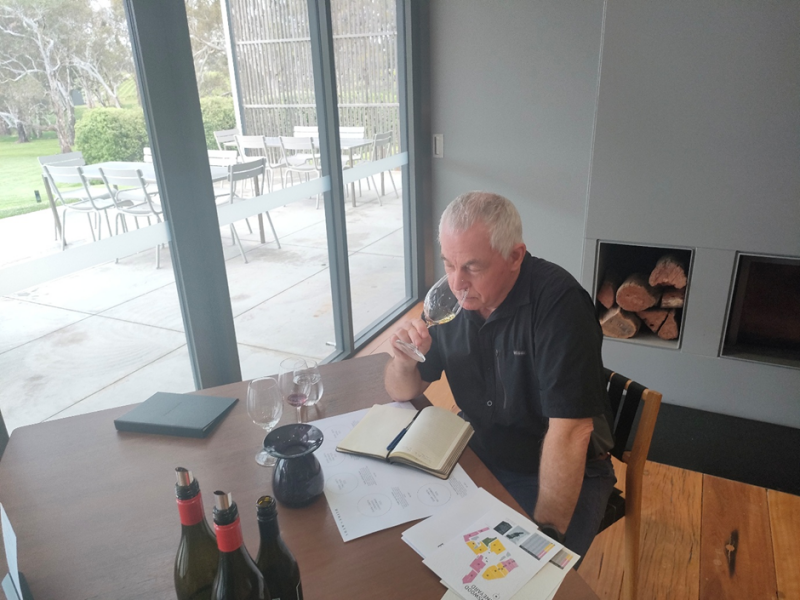
Is heaven the Shaw + Smith Tasting Room?
2023 Shaw + Smith Pinot Noir. Medium ruby in the glass with distinct red cherry and strawberry aromas, some rose florals and a bit of mushroom or forest floor. On the palate the tannins are silky, there is bright red cherry fruit and nice sous-bois base, good concentration and a long savoury finish, quite approachable now but better in a couple of years.
2023 Lenswood Pinot Noir. Handpicked and sorted fruit fermented with 50% whole bunches in a mix of oak and stainless, aged 10 months in 500 litre puncheons, 30% new. Medium ruby in the glass, with distinct rose and violet florals overlaying dark cherry fruit with a herbal edge. On the palate, fine savoury herbs mingle with red cherry fruit and sous-bois, finely balanced, elegant and quite long.
2022 Shiraz. From low yielding vines in Balhannah and central Adelaide Hills, with an initial cold soak, after fermentation aged 10 months in 5-600 litre French oak barrels 20% new and another 16 months in bottle before release. Dark ruby, tending purple in the glass, with a fragrant nose of violets, blackberry and white pepper. On the palate, ripe black and blue berry fruits with a slight herbal edge and tannins which are still gripping on the long finish, just a hint of smoked meat, a delicious cool climate Shiraz that will reward aging.
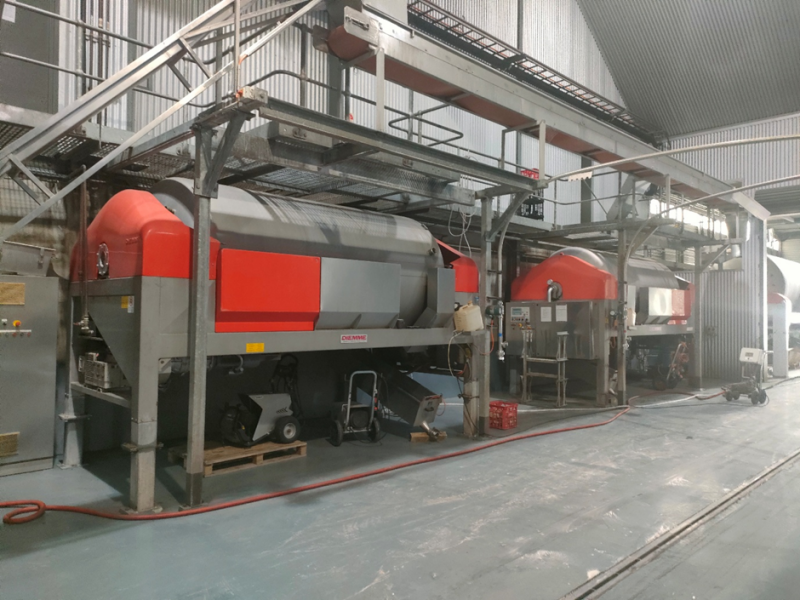
State of the art Diemme closed tank Pneumatic presses
2022 Balhannah Shiraz. Handpicked and sorted grapes from the Balhannah Vineyard aged 14 months in 5-600 litre French oak barrels 15% new then 14 months in bottle before release. Deep ruby purple in the glass with smoked paprika, pot-pourri and garrigue herbs on the nose. On the palate, the dark berry fruit is drenched with smoked meat, black pepper and garrigue herb overtones, the tannins are fine but still firm and the finish is long and structured. Another for the cellar.
2024 MMAD Blewitt Springs Chenin Blanc. From older vines in McLaren Vale and a cool wet season, grapes hand harvested and a combination of crushed and whole bunch pressed fruit was fermented in concrete and large format oak before maturing in French oak puncheons. Pale lemon in the glass with distinct aromas of apple, lemon wax and chamomile. A very textural palate with a sweet entry but some power on the dry finish.
MMAD Blewitt Springs 2023 Grenache. Deep ruby in the glass with bright red fruits and sandalwood spice on the nose. On the palate the berry compote fruit is powerful with drive, soft fine tannins, lovely acid balance, finishes with a slightly drying blood sausage and pencil shaving edge, delicious already but give this a couple more years!
Savagnin No 4 Fleurieu. An unexpected treat, Jura styled wine aged under flor yeast for up to 48 months, from 2021, 22 and 23 wines. A sweet aldehyde nose with apples and salted nuts. A distinct slightly coconut edged palate of Xmas nuts and candied citrus peel, finishes clean, fresh and salty, yum!
And that was the wash! An immensely rewarding and satisfying day in Adelaide Hills. Wonderfully diverse but always elegant wines, well-trained, knowledgeable and friendly cellar door staff, beautiful surroundings – both natural and architectural. I’ll be back!
If you enjoyed this weekly blog, you can subscribe for free using the contact form, or just email info@wineinsights.org. To see all my daily content follow me on Facebook.
I am considering leading a small group South Australia wine tour next year which will take in the Barossa Valley, McLaren Vale and Adelaide Hills, possibly Coonawarra as well. If this is something that might interest you, please indicate your interest using the contact form or email as above.
Add comment
Comments